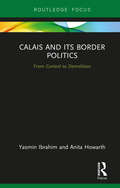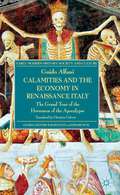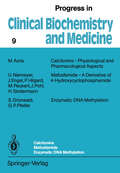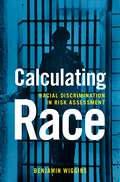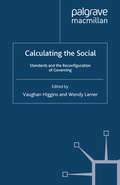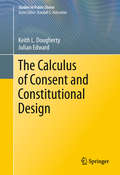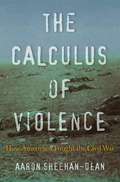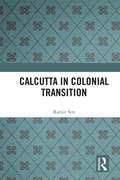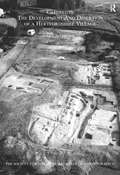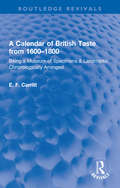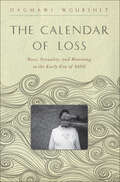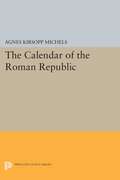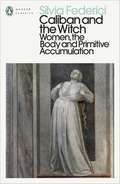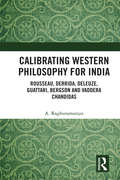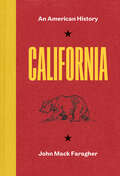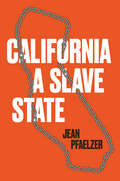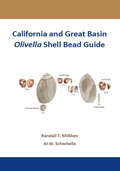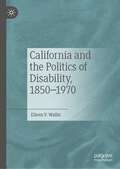- Table View
- List View
Calais and its Border Politics: From Control to Demolition
by Yasmin Ibrahim Anita HowarthCalais has a long history of transient refugee settlements and is often narrated through the endeavour to ‘sanitize’ it by both the English and the French in their policy and media discourses. Calais and its Border Politics encapsulates the border politics of Calais as an entry port through the refugee settlements known as the ‘Jungle’. By deconstructing how the jungle is a constant threat to the civilisation and sanity of Calais, the book traces the story of the jungle, both its revival and destruction as a recurrent narrative through the context of border politics. The book approaches Calais historically and through the key concept of the camp or the ‘jungle’ - a metaphor that becomes crucial to the inhuman approach to the settlement and in the justifications to destroy it continuously. The demolition and rebuilding of Calais also emphasises the denigration of humanity in the border sites. The authors offer a comprehensive insight into the making and unmaking of one of Europe’s long-standing refugee camps. The book explores the history of refugee camps in Calais and provides an insight into its representation and governance over time. The book provides an interdisciplinary perspective, employing concepts of space making, human form and corporeality, as well as modes of representation of the ‘Other’ to narrate the story of Calais as a border space through time, up to its recent representations in the media. This book’s exploration of the representation and governance of the contentious Calais camps will be an invaluable resource to students and scholars of forced migration, border politics, displacement, refugee crisis, camps and human trauma.
Calais and its Border Politics: From Control to Demolition
by Yasmin Ibrahim Anita HowarthCalais has a long history of transient refugee settlements and is often narrated through the endeavour to ‘sanitize’ it by both the English and the French in their policy and media discourses. Calais and its Border Politics encapsulates the border politics of Calais as an entry port through the refugee settlements known as the ‘Jungle’. By deconstructing how the jungle is a constant threat to the civilisation and sanity of Calais, the book traces the story of the jungle, both its revival and destruction as a recurrent narrative through the context of border politics. The book approaches Calais historically and through the key concept of the camp or the ‘jungle’ - a metaphor that becomes crucial to the inhuman approach to the settlement and in the justifications to destroy it continuously. The demolition and rebuilding of Calais also emphasises the denigration of humanity in the border sites. The authors offer a comprehensive insight into the making and unmaking of one of Europe’s long-standing refugee camps. The book explores the history of refugee camps in Calais and provides an insight into its representation and governance over time. The book provides an interdisciplinary perspective, employing concepts of space making, human form and corporeality, as well as modes of representation of the ‘Other’ to narrate the story of Calais as a border space through time, up to its recent representations in the media. This book’s exploration of the representation and governance of the contentious Calais camps will be an invaluable resource to students and scholars of forced migration, border politics, displacement, refugee crisis, camps and human trauma.
Calamities and the Economy in Renaissance Italy: The Grand Tour of the Horsemen of the Apocalypse (Early Modern History: Society and Culture)
by G. AlfaniItaly faced a number of catastrophes in the long sixteenth century. This economic and demographic history follows the consequences of these catastrophes - the action of the Horsemen of the Apocalypse - War, Famine and Plague, all followed by Death.
Calcitonins — Physiological and Pharmacological Aspects. Mafosfamide — A Derivative of 4-Hydroxycyclophosphamide. Enzymatic DNA Methylation (Progress in Clinical Biochemistry and Medicine #9)
by M. Azria J. Engel S. Grünwald P. Hilgard U. Niemeyer M. Peukert G. P. Pfeifer J. Pohl H. SindermannCalculating Race: Racial Discrimination in Risk Assessment
by Benjamin WigginsIn Calculating Race, Benjamin Wiggins analyzes the historical relationship between statistical risk assessment and race in the United States. He illustrates how, through a reliance on the variable of race, actuarial science transformed the nature of racism and helped usher racial disparities in wealth, incarceration, and housing from the nineteenth century into the twentieth. Wiggins begins by tracing how the life insurance industry utilized race in its calculations at the end of the nineteenth century, focusing particularly on Prudential and its aggressive battles with state regulators to discriminate against clients and adjust rates on the basis of race. He then turns his focus to the collection of racial statistics in the Illinois state penitentiary system in the late nineteenth century and the state's subsequent development of predictive sentencing and parole formulas in the 1920s that weighed race as a key factor. Next, he investigates the role of race in the state-sponsored mortgage insurance program of the Federal Housing Administration between the start of the New Deal and the beginning of the Cold War and its prolonged effects on mortgage lending. Wiggins concludes with an analysis of the use of race in the statistical risk assessments across financial institutions and government programs during the post-civil rights movement era, and how that practice has been transformed in the twenty-first century through "proxy" variables which stand in for the now taboo category of race. Offering readers a new perspective on the historical importance of actuarial science in structural racism, Calculating Race is a particularly timely contribution as Big Data and algorithmic decision making increasingly pervade our lives.
Calculating Race: Racial Discrimination in Risk Assessment
by Benjamin WigginsIn Calculating Race, Benjamin Wiggins analyzes the historical relationship between statistical risk assessment and race in the United States. He illustrates how, through a reliance on the variable of race, actuarial science transformed the nature of racism and helped usher racial disparities in wealth, incarceration, and housing from the nineteenth century into the twentieth. Wiggins begins by tracing how the life insurance industry utilized race in its calculations at the end of the nineteenth century, focusing particularly on Prudential and its aggressive battles with state regulators to discriminate against clients and adjust rates on the basis of race. He then turns his focus to the collection of racial statistics in the Illinois state penitentiary system in the late nineteenth century and the state's subsequent development of predictive sentencing and parole formulas in the 1920s that weighed race as a key factor. Next, he investigates the role of race in the state-sponsored mortgage insurance program of the Federal Housing Administration between the start of the New Deal and the beginning of the Cold War and its prolonged effects on mortgage lending. Wiggins concludes with an analysis of the use of race in the statistical risk assessments across financial institutions and government programs during the post-civil rights movement era, and how that practice has been transformed in the twenty-first century through "proxy" variables which stand in for the now taboo category of race. Offering readers a new perspective on the historical importance of actuarial science in structural racism, Calculating Race is a particularly timely contribution as Big Data and algorithmic decision making increasingly pervade our lives.
Calculating the Social: Standards and the Reconfiguration of Governing
by Vaughan Higgins Wendy LarnerExamining the increasingly powerful role of standards in the governing of economic, political and social life, this book draws upon governmentality and actor network theory to explore how standards and standardizing projects are articulated and rendered workable in practice, and the objects, subjects and forms of identity to which this gives rise.
The Calculus of Consent and Constitutional Design (Studies in Public Choice #20)
by Keith Dougherty Julian EdwardBuchanan and Tullock’s seminal work, The Calculus of Consent, linked economic methodology to substantive questions in political science. Among the major contributions of their book is a connection between constitutional decision making and contractarianism, a philosophical tradition that proponents believe can give institutions legitimacy. In other words, a major contribution of their book is a clear connection between empirical decision making and normative principles. The current book formalizes and extends their foundational ideas as it attempts to show how economic and philosophical arguments about the "best" voting rules can be used to improve constitutional design. It informs debates about constitutional political economy in comparative politics, democratic theory, and public choice. Political scientists often ask questions about what causes a nation to seek a new constitution, how constitutions are made, and what factors allow for corrupt decision making. The Calculus of Consent and Constitutional Design bridges the gap between normative questions about which institutions are most efficient and fair and empirical questions about how constitutions are formed. This provides a benchmark to help create better constitutions and informs empirical research about what institutions are most likely to succeed. The book begins by showing how contractarian ideals can be used to justify choices about decision-making. It then carefully defines several concepts employed by Buchanan and Tullock and shows why the relationships between these concepts may not be as closely linked as Buchanan and Tullock first thought. This provides a backdrop for analyzing the three phases of constitutional decision-making: 1) the constitutional phase, where rules for constitutional decision making must be justified; 2) the legislative phase, where the optimal k-majority rule is analyzed; and 3) the electoral phase, where the optimal voting rule for large electorates and open alternatives are determined. These phases differ by context and sources of legitimacy. Computational models and analytic techniques are introduced in each of these chapters. Finally, the book concludes with statements about the significance of the research for the creation of constitutions more broadly.
The Calculus of Violence: How Americans Fought the Civil War
by Aaron Sheehan-DeanDiscarding tidy abstractions about the conduct of war, Aaron Sheehan-Dean shows that the notoriously bloody US Civil War could have been much worse. Despite agonizing debates over Just War and careful differentiation among victims, Americans could not avoid living with the contradictions inherent in a conflict that was both violent and restrained.
Calcutta in Colonial Transition
by Ranjit SenThis book brings home the story of how three clustered villages grew into a primate city, in which a garrison town, a port city and the capital of an empire merged into one entity—Calcutta. This and its companion volume Birth of a Colonial City examine the geopolitical factors that were significant in securing Calcutta's position in the light of growing influence of the East India Company and subsequently the British Empire. A definitive history of Calcutta in its nascent years, this book discusses the challenges of city-planning, the de-industrialization at the hands of British imperialists, the catastrophic fall of the Union Bank, the advent of British capital, and the rise of the Bengali business enterprise in the colonial era. It also underlines how Calcutta facilitated the development of a political consciousness and the pivotal political and cultural role it played when the movement for independence took hold in the country. This volume will be of great interest to scholars and researchers of modern South Asian history, British Studies, city and area studies.
Calcutta in Colonial Transition
by Ranjit SenThis book brings home the story of how three clustered villages grew into a primate city, in which a garrison town, a port city and the capital of an empire merged into one entity—Calcutta. This and its companion volume Birth of a Colonial City examine the geopolitical factors that were significant in securing Calcutta's position in the light of growing influence of the East India Company and subsequently the British Empire. A definitive history of Calcutta in its nascent years, this book discusses the challenges of city-planning, the de-industrialization at the hands of British imperialists, the catastrophic fall of the Union Bank, the advent of British capital, and the rise of the Bengali business enterprise in the colonial era. It also underlines how Calcutta facilitated the development of a political consciousness and the pivotal political and cultural role it played when the movement for independence took hold in the country. This volume will be of great interest to scholars and researchers of modern South Asian history, British Studies, city and area studies.
Caldecote: The Development and Desertion of a Hertfordshire Village (The Society for Medieval Archaeology Monographs)
by Guy Beresford"At just 132 hectares (325 acres) the parish of Caldecote is one of the smallest parishes in Hertfordshire. Today the settlement comprises the manor house, until recently surrounded by a range of traditional farm buildings, together with six labourer's cottages and the church. To the north lies the site of the old rectory and the earthworks of a medieval settlement. In 1973 the Department of Environment and the Deserted Medieval Village Research Group arranged a rescue excavation to examine the earthworks of the medieval village before they were levelled and ploughed. Five crofts, the old rectory site and much of the moated enclosure were investigated in one of the largest excavations ever conducted on a later medieval rural site in Britain. Though the excavations did recover a Bronze Age beaker burial and small quantities of Roman and Iron Age pottery, the medieval settlement at Caldecote was probably founded in the 10th century, and by the time of the Domesday Survey there was a church, a priest and nine villeins. A moated site was added in the 13th century. A century later, Caldecote was granted to the abbots of the Benedictine monastery in St Albans, at a time when there were seventeen householders. Early in the second half of the 14th century, the estate and demesne were subdivided into six farms, each complete with a hall-house and two or more barns. Following the dissolution of the monastery in 1539, the manor was again held by an absentee lord and the farms continued to prosper. However, the late 16th and early 17th centuries, for which there are several surviving wills and inventories, saw their gradual abandonment.After the desertion of Caldecote Marish in 1698, Caldecote was farmed as a single unit until 1970, when the estate was attached to that adjoining the manor of Newnham. Of particular importance from Caldecote is the archaeological evidence for medieval peasant structures, the development of the later medieval domestic plan and the structural transformation of post-medieval period houses including the insertion of chimneys and second storeys. The medieval and later pottery assemblage is of regional importance for its size and the range of fabrics represented. The metalwork comprises many objects of personal adornment, household utensils, and tools for woodwork, agriculture and the manufacture of textiles. Other finds include copper-alloy objects both domestic and agricultural, whetstones, quernstones, mortars and clay pipes. Although the economy of Caldecote was always dependant on arable farming, the faunal remains elucidate aspects of the medieval diet and details of the livestock maintained on the holdings."
Caldecote: The Development and Desertion of a Hertfordshire Village (The Society for Medieval Archaeology Monographs)
by Guy Beresford"At just 132 hectares (325 acres) the parish of Caldecote is one of the smallest parishes in Hertfordshire. Today the settlement comprises the manor house, until recently surrounded by a range of traditional farm buildings, together with six labourer's cottages and the church. To the north lies the site of the old rectory and the earthworks of a medieval settlement. In 1973 the Department of Environment and the Deserted Medieval Village Research Group arranged a rescue excavation to examine the earthworks of the medieval village before they were levelled and ploughed. Five crofts, the old rectory site and much of the moated enclosure were investigated in one of the largest excavations ever conducted on a later medieval rural site in Britain. Though the excavations did recover a Bronze Age beaker burial and small quantities of Roman and Iron Age pottery, the medieval settlement at Caldecote was probably founded in the 10th century, and by the time of the Domesday Survey there was a church, a priest and nine villeins. A moated site was added in the 13th century. A century later, Caldecote was granted to the abbots of the Benedictine monastery in St Albans, at a time when there were seventeen householders. Early in the second half of the 14th century, the estate and demesne were subdivided into six farms, each complete with a hall-house and two or more barns. Following the dissolution of the monastery in 1539, the manor was again held by an absentee lord and the farms continued to prosper. However, the late 16th and early 17th centuries, for which there are several surviving wills and inventories, saw their gradual abandonment.After the desertion of Caldecote Marish in 1698, Caldecote was farmed as a single unit until 1970, when the estate was attached to that adjoining the manor of Newnham. Of particular importance from Caldecote is the archaeological evidence for medieval peasant structures, the development of the later medieval domestic plan and the structural transformation of post-medieval period houses including the insertion of chimneys and second storeys. The medieval and later pottery assemblage is of regional importance for its size and the range of fabrics represented. The metalwork comprises many objects of personal adornment, household utensils, and tools for woodwork, agriculture and the manufacture of textiles. Other finds include copper-alloy objects both domestic and agricultural, whetstones, quernstones, mortars and clay pipes. Although the economy of Caldecote was always dependant on arable farming, the faunal remains elucidate aspects of the medieval diet and details of the livestock maintained on the holdings."
A Calendar of British Taste from 1600–1800: Being a Museum of Specimens & Landmarks Chronologically Arranged (Routledge Revivals)
by E. F. CarrittFirst published in 1948, A Calendar of British Taste from 1600–1800 gives a picture of British taste in art, nature and manners during the centuries 1600 to 1800. The book is an anthology from novels, poetry, letters, essays, advertisements and diaries of the period. It is arranged chronologically and covers a wide range of topics including architecture, gardens, manners, music, nature, painting, poetry, sculpture, and the stage. Key authors drawn upon include Pepys, Dryden, Pope, Horace Walpole, Dr. Johnson, Fanny Burney, Cowper, and Wordsworth. Through an extensive and panoramic view, the book traces the development and changes in taste over time. A Calendar of British Taste from 1600–1800 is ideal for anyone with an interest in the cultural and social history of Britain.
A Calendar of British Taste from 1600–1800: Being a Museum of Specimens & Landmarks Chronologically Arranged (Routledge Revivals)
by E. F. CarrittFirst published in 1948, A Calendar of British Taste from 1600–1800 gives a picture of British taste in art, nature and manners during the centuries 1600 to 1800. The book is an anthology from novels, poetry, letters, essays, advertisements and diaries of the period. It is arranged chronologically and covers a wide range of topics including architecture, gardens, manners, music, nature, painting, poetry, sculpture, and the stage. Key authors drawn upon include Pepys, Dryden, Pope, Horace Walpole, Dr. Johnson, Fanny Burney, Cowper, and Wordsworth. Through an extensive and panoramic view, the book traces the development and changes in taste over time. A Calendar of British Taste from 1600–1800 is ideal for anyone with an interest in the cultural and social history of Britain.
The Calendar of Loss: Race, Sexuality, and Mourning in the Early Era of AIDS (The <I>Callaloo</I> African Diaspora Series)
by Dagmawi WoubshetHis world view colored by growing up in 1980s Ethiopia, where death governed time and temperament, Dagmawi Woubshet offers a startlingly fresh interpretation of melancholy and mourning during the early years of the AIDS epidemic in The Calendar of Loss.When society denies a patient's disease and then forbids survivors mourning rites, how does a child bear witness to a parent's death or a lover grieve for his beloved? Looking at a range of high and popular works of grief�including elegies, eulogies, epistles to the dead, funerals, and obituaries�Woubshet identifies a unique expression of mourning that emerged in the 1980s and early 1990s in direct response to the AIDS catastrophe. What Woubshet dubs a "poetics of compounding loss" expresses what it was like for queer mourners to grapple with the death of lovers and friends in rapid succession while also coming to terms with the fact of their own imminent mortality. The time, consolation, and closure that allow the bereaved to get through loss were for the mourners in this book painfully thwarted, since with each passing friend, and with mounting numbers of the dead, they were provided with yet more evidence of the certain fatality of the virus inside them. Ultimately, the book argues, these disprized mourners turned to their sorrow as a necessary vehicle of survival, placing open grief at the center of art and protest, insisting that lives could be saved through the very speech acts precipitated by death. An innovative and moving study, The Calendar of Loss illuminates how AIDS mourning confounds and traverses how we have come to think about loss and grief, insisting that the bereaved can confront death in the face of shame and stigma in eloquent ways that also imply a fierce political sensibility and a longing for justice.
Calendar of the Roman Republic (PDF)
by Agnes Kirsopp MichelsThis book reconstructs the pre-Julian calendar of Rome on the basis of epigraphical and literary evidence, and analyzes its relation to the solar and lunar years. Mrs. Michels shows how the varied contents of the calendar were related to the political as well as to the religious life of Rome of the first century B.C. She traces the history of the calendar back to the fifth century, indicating the stages by which a single list of festivals may have developed into the complex document of the late republic. The Roman method of intercalation, the character of the days, and the history of the trinum nundinum are presented in appendices.Originally published in 1967.The Princeton Legacy Library uses the latest print-on-demand technology to again make available previously out-of-print books from the distinguished backlist of Princeton University Press. These editions preserve the original texts of these important books while presenting them in durable paperback and hardcover editions. The goal of the Princeton Legacy Library is to vastly increase access to the rich scholarly heritage found in the thousands of books published by Princeton University Press since its founding in 1905.
Caliban and the Witch: Women, the Body and Primitive Accumulation (Penguin Modern Classics)
by Silvia Federici'A groundbreaking work . . . Federici has become a crucial figure for . . . a new generation of feminists' Rachel Kushner, author of The Mars RoomA cult classic since its publication in the early years of this century, Caliban and the Witch is Silvia Federici's history of the body in the transition to capitalism. Moving from the peasant revolts of the late Middle Ages through the European witch-hunts, the rise of scientific rationalism and the colonisation of the Americas, it gives a panoramic account of the often horrific violence with which the unruly human material of pre-capitalist societies was transformed into a set of predictable and controllable mechanisms. It Is a study of indigenous traditions crushed, of the enclosure of women's reproductive powers within the nuclear family, and of how our modern world was forged in blood.'Rewarding . . . allows us to better understand the intimate relationship between modern patriarchy, the rise of the nation state and the transition from feudalism to capitalism' Guardian
Calibrating Western Philosophy for India: Rousseau, Derrida, Deleuze, Guattari, Bergson and Vaddera Chandidas
by A. RaghuramarajuThis book proposes a new way of reading modern Western philosophers in the Indian context. It questions the colonial methodology, or the practice of importing theories of Western philosophy, and shows how its unmediated applications are often incongruent, irrelevant, and unproductive in local frameworks. The author shows an alternative route to approaching philosophers from the West – Rousseau, Derrida, Deleuze, Guattari, and Bergson – by bending and reassembling aspects of their ideas and theories to relate with the diversity and complexity of Indian society. He also offers insights on the politics of non-being and negation from a neglected modern Indian philosopher, Vaddera Chandidas, as a step forward from the Western philosophers presented here. An intervention in philosophical research methodology, this volume will interest scholars and researchers of philosophy, Western philosophy, Indian philosophy, comparative studies, postcolonial studies, literature, cultural studies, and political philosophy.
Calibrating Western Philosophy for India: Rousseau, Derrida, Deleuze, Guattari, Bergson and Vaddera Chandidas
by A. RaghuramarajuThis book proposes a new way of reading modern Western philosophers in the Indian context. It questions the colonial methodology, or the practice of importing theories of Western philosophy, and shows how its unmediated applications are often incongruent, irrelevant, and unproductive in local frameworks. The author shows an alternative route to approaching philosophers from the West – Rousseau, Derrida, Deleuze, Guattari, and Bergson – by bending and reassembling aspects of their ideas and theories to relate with the diversity and complexity of Indian society. He also offers insights on the politics of non-being and negation from a neglected modern Indian philosopher, Vaddera Chandidas, as a step forward from the Western philosophers presented here. An intervention in philosophical research methodology, this volume will interest scholars and researchers of philosophy, Western philosophy, Indian philosophy, comparative studies, postcolonial studies, literature, cultural studies, and political philosophy.
California: An American History
by John Mack FaragherA concise and lively history of California, the most multicultural state in the nation “A masterful history.” —Kirkus Reviews (starred review) “Faragher takes the reader on a captivating journey through myriad twists and turns of California’s multicultural history, enlivened by stories of people who rarely penetrate our traditional state chronicles.”—Carlos E. Cortés, University of California, Riverside California is the most multicultural state in the nation. As John Mack Faragher argues in this concise and lively history, that is nothing new. California's natural variety has always supported diversity, including Native peoples speaking dozens of distinct languages, Spanish and Mexican colonists, gold seekers from all corners of the globe, and successive migrant waves from the eastern states, Europe, Latin America, Asia, and the Pacific Islands. Beautifully crafted and elegantly written, Faragher tells the stories of a colorful cast of characters, some famous, others mostly unknown, including African American Archy Lee, who sued for his freedom; Sinkyone Indian woman Sally Bell, who survived genocide; and Jewish schoolgirl Marilyn Greene, who spoke up for her Japanese friends after Pearl Harbor. California's multicultural diversity often led to conflict, turmoil, and violence, but also to invention, improvisation, and a struggle for multicultural democracy.
California, a Slave State (The Lamar Series in Western History)
by Jean PfaelzerThe untold history of slavery and resistance in California, from the Spanish missions, indentured Native American ranch hands, Indian boarding schools, Black miners, kidnapped Chinese prostitutes, and convict laborers to victims of modern trafficking “A searing survey of ‘250 years of human bondage’ in what is now the state of California. . . . Readers will be outraged.”—Publishers Weekly California owes its origins and sunny prosperity to slavery. Spanish invaders captured Indigenous people to build the chain of Catholic missions. Russian otter hunters shipped Alaska Natives—the first slaves transported into California—and launched a Pacific slave triangle to China. Plantation slaves were marched across the plains for the Gold Rush. San Quentin Prison incubated California’s carceral state. Kidnapped Chinese girls were sold in caged brothels in early San Francisco. Indian boarding schools supplied new farms and hotels with unfree child workers. By looking west to California, Jean Pfaelzer upends our understanding of slavery as a North-South struggle and reveals how the enslaved in California fought, fled, and resisted human bondage. In unyielding research and vivid interviews, Pfaelzer exposes how California gorged on slavery, an appetite that persists today in a global trade in human beings lured by promises of jobs but who instead are imprisoned in sweatshops and remote marijuana grows, or sold as nannies and sex workers. Slavery shreds California’s utopian brand, rewrites our understanding of the West, and redefines America’s uneasy paths to freedom.
California and Great Basin Olivella Shell Bead Guide
by Randall T Milliken Al W SchwitallaOlivella shell beads are ubiquitous at Central California Indian sites and were traded far inland by the local inhabitants. Their distinctive patterns of manufacture provide archaeologists with important chronological, morphological, and distributional information. This guide—authored by a professional artifact replicator and an archaeological expert on shell bead typology-- offers a well developed 16-category typology, including the descriptive, temporal, and metric characteristics of each style, illustrated with almost 200 color photographs. Spiral bound to facilitate field and laboratory work, it is an essential tool for conducting archaeology in the American west. Sponsored by the Society for California Archaeology and Pacific Legacy, Inc.
California and Great Basin Olivella Shell Bead Guide
by Randall T Milliken Al W SchwitallaOlivella shell beads are ubiquitous at Central California Indian sites and were traded far inland by the local inhabitants. Their distinctive patterns of manufacture provide archaeologists with important chronological, morphological, and distributional information. This guide—authored by a professional artifact replicator and an archaeological expert on shell bead typology-- offers a well developed 16-category typology, including the descriptive, temporal, and metric characteristics of each style, illustrated with almost 200 color photographs. Spiral bound to facilitate field and laboratory work, it is an essential tool for conducting archaeology in the American west. Sponsored by the Society for California Archaeology and Pacific Legacy, Inc.
California and the Politics of Disability, 1850–1970
by Eileen V. WallisThis book explores the political, legal, medical, and social battles that led to the widespread institutionalization of Californians with disabilities from the gold rush to the 1970s. By the early twentieth century, most American states had specialized facilities dedicated to both the care and the control of individuals with disabilities. Institutions reflect the lived historical experience of many Americans with disabilities in this era. Yet we know relatively little about how such state institutions fit into specific regional, state, or local contexts west of the Mississippi River; how those contexts shaped how institutions evolved over time; or how regional institutions fit into the USA’s contentious history of care and control of Americans with mental and developmental disabilities. This book examines how medical, social, and political arguments that individuals with disabilities needed to be institutionalized became enshrined in state law in California through the creation of a “bureaucracy of disability.” Using Los Angeles County as a case study, the book also considers how the friction between state and county policy in turn influenced the treatment of individuals within such facilities. Furthermore, the book tracks how the mission and methods of such institutions evolved over time, culminating in the 1960s with the birth of the disability rights movement and the complete rewriting of California’s laws on the treatment and rights of Californians with disabilities. This book is a must-read for those interested in the history of California and the American West and for anyone interested in how the intersections of disability, politics, and activism shaped our historical understanding of life for Americans with disabilities.
